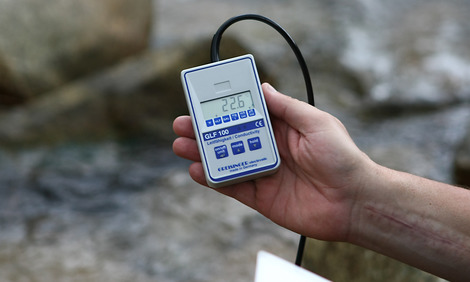An aquarium is more than a fascinating piece of nature in your home: it’s also a sensitive ecosystem that requires careful attention and care. Ensuring the best living conditions for your aquarium pets should always be your top priority. And temperature plays a central role in this. In aquariums, it is of crucial importance for your animals and plants and therefore definitely needs to be monitored. Most tropical ornamental fish feel most comfortable at temperatures between 24 and 26 °C. There are, however, also fish that prefer lower temperatures. The discus is a species that flourishes in higher temperatures between 27 and 29 °C. Axolotls and many freshwater shrimps prefer cooler temperatures.
A thermometer for the aquarium is an indispensable tool to ensure your water temperature is always within the ideal range. There’s a lot on the market when it comes to aquarium temperatures, so we thought we would give you an outline of all the thermometers in our range.
Digital thermometers for the aquarium
JBL Aquarium Thermometer DigiScan Tube
A digital aquarium thermometer which is attached to the filter hose carrying the water. The sensitive temperature sensor on the back measures the temperature of the aquarium water via the hose temperature, which is identical to the water temperature. It fits all hoses and hose types from 12-26 mm diameter and is equipped with a preset alarm below 18 °C and above 28 °C.
Find out more: JBL Termómetro para acuarios DigiScan Tube (¡No sumergir nunca en el agua!)
JBL Aquarium Thermometer DigiScan
This is a digital adhesive aquarium pane thermometer. Simply stick it onto the clean aquarium glass from the outside and press. The thermometer can be removed easily at any time thanks to the 2-part Velcro sticker. The water temperature is transmitted very accurately through the aquarium pane to the temperature contact on the back of the thermometer.
Find out more: JBL Termómetro para acuarios DigiScan (¡No sumergir nunca en el agua!)
JBL Aquarium Thermometer DigiScan Alarm
This is a digital adhesive aquarium pane thermometer with alarm function. It is also attached to the aquarium by sticking and pressing it onto the cleaned aquarium pane from the outside. The thermometer can be easily removed at any time thanks to the 4-part Velcro sticker. The water temperature is transmitted very accurately through the aquarium pane to the temperature contact on the back of the thermometer. The alarm function consists of a flashing display. It activates as soon as the water temperature is below 18 °C or above 28 °C.
Find out more: JBL Termómetro para acuarios DigiScan Alarm (¡No sumergir nunca en el agua!)
JBL Aquarium Thermometer Digital
The classic among thermometers. A thermometer strip that is easy to stick to the outside of the aquarium pane. It shows you the current temperature and the optimal temperature range.
Find out more: JBL Termómetro digital para acuarios
Analogue thermometers for the aquarium
JBL Aquarium Thermometer Float
A very simple glass thermometer with a suction holder, which is acid and alkali resistant. The optimal temperature range is displayed in green. If the thermometer is not attached, it floats vertically on the surface of the water.
Find out more: JBL Termómetro flotante para acuarios
JBL Aquarium Thermometer Mini
A clever little thermometer that is ideal for small aquariums. Keep an eye on the temperature at all times with its fine scale with 2 °C increments. It is 60 mm long and has a diameter of 5 mm. The thermometer is filled with a non-toxic alcohol liquid.
Find out more: JBL Minitermómetro para acuarios
JBL Aquarium Thermometer Slim
A slimline glass aquarium thermometer, which is 15 cm long and can therefore be read very precisely. It is equipped with a suction holder (acid and alkali resistant) for easy attachment to the aquarium glass.
Find out more: JBL Termómetro fino para acuarios
It is often said that digital thermometers are much more reliable than analogue ones. However, it is important to familiarise yourself with the ins and outs of display accuracy and measurement accuracy. These are discussed in more detail in the following blog post: Display Accuracy vs. Measuring Accuracy - Different Results When Measuring Temperatures
